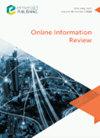The effect of social media environments on online emotional disclosure: tie strength, network size and self-reference
IF 3.1
3区 管理学
Q2 COMPUTER SCIENCE, INFORMATION SYSTEMS
引用次数: 0
Abstract
PurposeMotivating users to self-disclose online is significant to the long-term development of social media. Therefore, research on emotional disclosure, a significant form of self-disclosure, is required. By developing a stimulus-organism-response model, this study aims to investigate the mechanisms by which the social media environment affects users' online emotional disclosure.Design/methodology/approachThis paper proposes two dimensions of social media environments, the online interpersonal environment (tie strength and network size) and the online information environment (self-reference). They are hypothesized to stimulate users' internal psychological needs (image management and emotional expression) which in turn will influence their emotional disclosure intentions. Using data from 489 users of WeChat Moments, the authors conduct partial least squares analysis to validate the research model.FindingsThe findings show that users' intrinsic psychological needs are stimulated by social media environments, but network size is not correlated with the need for emotional expression. The user's need for emotional expression promotes both positive and negative emotional disclosure intentions. The need for image management has a positive impact on positive emotion disclosure intentions but has a negative impact on negative emotion disclosure intentions.Originality/valueThis study contributes to the understanding of online emotional disclosure. It can also help social media managers create efficient plans to encourage users to create content.Peer reviewThe peer review history for this article is available at: https://publons.com/publon/10.1108/OIR-04-2022-0245.社交媒体环境对网络情感表露的影响:纽带强度、网络规模和自我参照
激励用户在线自我披露对社交媒体的长远发展具有重要意义。因此,有必要对自我表露的重要形式——情绪表露进行研究。通过建立刺激-机体-反应模型,本研究旨在探讨社交媒体环境影响用户在线情感披露的机制。本文提出了社交媒体环境的两个维度,即网络人际环境(关系强度和网络规模)和网络信息环境(自我参照)。它们被假设为刺激用户的内在心理需求(形象管理和情感表达),进而影响他们的情感披露意图。作者利用489名微信朋友圈用户的数据,进行偏最小二乘分析来验证研究模型。研究结果表明,用户的内在心理需求受到社交媒体环境的刺激,但网络规模与情感表达需求无关。用户对情感表达的需求促进了积极和消极的情感表露意图。形象管理需求对积极情绪披露意愿有正向影响,对消极情绪披露意愿有负向影响。原创性/价值本研究有助于理解网络情感表露。它还可以帮助社交媒体管理者制定有效的计划,鼓励用户创建内容。同行评议本文的同行评议历史可在:https://publons.com/publon/10.1108/OIR-04-2022-0245。
本文章由计算机程序翻译,如有差异,请以英文原文为准。
求助全文
约1分钟内获得全文
求助全文
来源期刊

Online Information Review
工程技术-计算机:信息系统
CiteScore
6.90
自引率
16.10%
发文量
67
审稿时长
6 months
期刊介绍:
The journal provides a multi-disciplinary forum for scholars from a range of fields, including information studies/iSchools, data studies, internet studies, media and communication studies and information systems.
Publishes research on the social, political and ethical aspects of emergent digital information practices and platforms, and welcomes submissions that draw upon critical and socio-technical perspectives in order to address these developments.
Welcomes empirical, conceptual and methodological contributions on any topics relevant to the broad field of digital information and communication, however we are particularly interested in receiving submissions that address emerging issues around the below topics.
Coverage includes (but is not limited to):
•Online communities, social networking and social media, including online political communication; crowdsourcing; positive computing and wellbeing.
•The social drivers and implications of emerging data practices, including open data; big data; data journeys and flows; and research data management.
•Digital transformations including organisations’ use of information technologies (e.g. Internet of Things and digitisation of user experience) to improve economic and social welfare, health and wellbeing, and protect the environment.
•Developments in digital scholarship and the production and use of scholarly content.
•Online and digital research methods, including their ethical aspects.
 求助内容:
求助内容: 应助结果提醒方式:
应助结果提醒方式:


